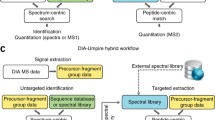Abstract
In mass spectrometry–based proteomics, data-independent acquisition (DIA) strategies can acquire a single data set useful for both identification and quantification of detectable peptides in a complex mixture. However, DIA data are noisy owing to a typical five- to tenfold reduction in precursor selectivity compared to data obtained with data-dependent acquisition or selected reaction monitoring. We demonstrate a multiplexing strategy, MSX, for DIA analysis that increases precursor selectivity fivefold.



Similar content being viewed by others
References
Stahl, D.C., Swiderek, K.M., Davis, M.T. & Lee, T.D. J. Am. Soc. Mass Spectrom. 7, 532–540 (1996).
Liu, H., Sadygov, R.G. & Yates, J.R. Anal. Chem. 76, 4193–4201 (2004).
Michalski, A., Cox, J. & Mann, M. J. Proteome Res. 10, 1785–1793 (2011).
Wenner, B.R. & Lynn, B.C. J. Am. Soc. Mass Spectrom. 15, 150–157 (2004).
Hoopmann, M.R., Finney, G.L. & MacCoss, M.J. Anal. Chem. 79, 5620–5632 (2007).
Purvine, S., Eppel, J.T., Yi, E.C. & Goodlett, D.R. Proteomics 3, 847–850 (2003).
Myung, S. et al. Anal. Chem. 75, 5137–5145 (2003).
Venable, J.D., Dong, M.Q., Wohlschlegel, J., Dillin, A. & Yates, J.R. Nat. Methods 1, 39–45 (2004).
Panchaud, A. et al. Anal. Chem. 81, 6481–6488 (2009).
Weisbrod, C.R., Eng, J.K., Hoopmann, M.R., Baker, T. & Bruce, J.E. J. Proteome Res. 11, 1621–1632 (2012).
Gillet, L.C. et al. Mol. Cell Proteomics 11, O111.016717 (2012).
Williams, E.R., Loh, S.Y., McLafferty, F.W. & Cody, R.B. Anal. Chem. 62, 698–703 (1990).
MacLean, B. et al. Bioinformatics 26, 966–968 (2010).
US National Institute of Standards and Technology. NIST Peptide Tandem Mass Spectral Libraries (eds. Stein, S.E. & Rudnick, P.A.) 〈http://peptide.nist.gov/〉 (2009; 24 May 2011 builds).
Yost, R.A. & Enke, C.G. Anal. Chem. 51, 1251–1264 (1979).
Frahm, J.L., Howard, B.E., Heber, S. & Muddiman, D.C. J. Mass Spectrom. 41, 281–288 (2006).
Gay, S., Binz, P.A., Hochstrasser, D.F. & Appel, R.D. Electrophoresis 20, 3527–3534 (1999).
Frewen, B.E., Merrihew, G.E., Wu, C.C., Noble, W.S. & MacCoss, M.J. Anal. Chem. 78, 5678–5684 (2006).
Lawson, C.L. & Hanson, R.J. Solving Least Squares Problems (Society for Industrial and Applied Mathematics, Philadelphia, 1995).
Chambers, M.C. et al. Nat. Biotechnol. 30, 918–920 (2012).
Acknowledgements
The authors acknowledge financial support from US National Institutes of Health grants R01 GM103551, P41 GM103533 and F31 AG037265.
Author information
Authors and Affiliations
Contributions
A.K., C.C.W., J.D.C., J.D.E., M.J.M., M.K., V.Z. and Y.S.T. designed experiments. A.K., C.C.W., J.D.E., M.J.M., M.K., N.W.B. and V.Z. interpreted results. J.D.E. and M.J.M. wrote the manuscript. A.K. created a firmware modification for the Q-Exactive. A.K. and M.K. provided preliminary data. G.E.M., J.D.E. and N.W.B. performed experiments. B.X.M., D.M.M. and J.D.E. wrote software.
Corresponding author
Ethics declarations
Competing interests
All authors received financial support from Thermo Fisher Scientific. A.K., J.D.C., M.K. and V.Z. are employees of Thermo Fisher Scientific, the company that markets and sells the mass spectrometry instrumentation used in this manuscript. Thermo Fisher will make the methods described herein available to their customers in version 2.2 SP1 of the Q-Exactive software.
Supplementary information
Supplementary Text and Figures
Supplementary Figures 1–8, Supplementary Tables 1 and 2, Supplementary Data and Supplementary Note (PDF 3353 kb)
Supplementary Video 1
Demonstration of multiplexed data-independent acquisition (MSX) and demultiplexing (MOV 5308 kb)
Rights and permissions
About this article
Cite this article
Egertson, J., Kuehn, A., Merrihew, G. et al. Multiplexed MS/MS for improved data-independent acquisition. Nat Methods 10, 744–746 (2013). https://doi.org/10.1038/nmeth.2528
Received:
Accepted:
Published:
Issue Date:
DOI: https://doi.org/10.1038/nmeth.2528
- Springer Nature America, Inc.
This article is cited by
-
Sampling the proteome by emerging single-molecule and mass spectrometry methods
Nature Methods (2023)
-
Analysis of DIA proteomics data using MSFragger-DIA and FragPipe computational platform
Nature Communications (2023)
-
Prediction of peptide mass spectral libraries with machine learning
Nature Biotechnology (2023)
-
A peptide-centric quantitative proteomics dataset for the phenotypic assessment of Alzheimer’s disease
Scientific Data (2023)
-
Critical evaluation of MS acquisition conditions and identification process in LC-Q-Orbitrap-MS for non-targeted analysis: pesticide residues as case of study
Analytical and Bioanalytical Chemistry (2023)





